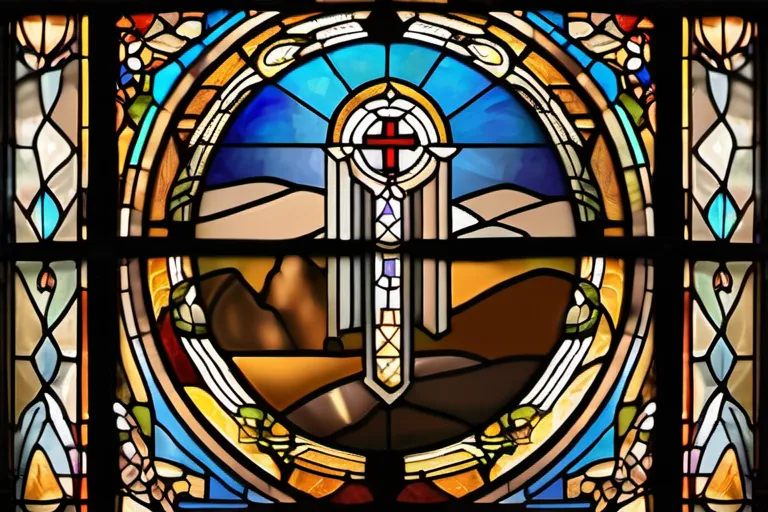Exploring the historical and contemporary connections between Jesus, Judaism, and modern religious practices.
This article delves into the profound impact of Jesus on Judaism and how this relationship continues to shape modern religious practices. From the origins of Christianity to its evolution over centuries, we will explore the complex interplay between these two faiths.
The Historical Context: Jesus in First Century Palestine
Imagine stepping back into first-century Palestine, where the life and teachings of Jesus were woven deeply within the fabric of Judaism. The political climate was tense, a delicate balance on the brink of upheaval. How did this setting shape not only his ministry but also the foundations of what would later become Christianity? Let’s dive into the historical context that provides a lens through which we can understand Jesus in Judaism and its lasting impact on modern religious practices.
In those days, Jerusalem was both a spiritual and political center, where tradition met the tumultuous waters of Roman rule. The Temple stood as a symbol of Jewish identity and covenant with God, yet it also faced challenges from Herod’s扩建和改革,这些变化引发了民众的不满。这一切背景下的耶稣,他的言行不仅受到了当时社会的关注,也预示了未来宗教实践的变化。
Jesus came not to replace the law but to fulfill it (Matthew 5:17), a statement that echoes through the ages. He moved among the people, challenging their interpretations of Mosaic Law and offering a fresh perspective on what it means to be faithful. His sermons, such as the Sermon on the Mount in Matthew, reflect a deep understanding of Jewish tradition while pushing boundaries with radical ideas about compassion, forgiveness, and righteousness.
The historical context here is crucial for grasping why Jesus’ teachings resonated so deeply. The socio-political backdrop of oppression and longing for deliverance created fertile ground for his message of hope and liberation. This setting also underscores the complex relationship between Judaism and Christianity, where Christianity emerged from within yet diverged significantly over time.
The Emergence of Christianity: A Break from Judaism
The emergence of Christianity as a break from Judaism was a complex and significant evolution, marked by doctrinal differences that profoundly impacted modern religious practices. As we delve into this transformation, one can’t help but ponder: how did these initial divisions shape the religious landscape we see today? The story begins with the teachings of Jesus, who, while deeply rooted in Jewish tradition, introduced new ideas that gradually set his followers apart from their fellow Jews.
At first glance, the divide between Judaism and early Christianity seemed subtle. Both religions shared many foundational texts and rituals. However, over time, key differences emerged. For instance, Christian beliefs about Jesus’ role as the Messiah were in stark contrast to Jewish expectations of a messianic figure who would restore political sovereignty rather than spiritual salvation.
The concept of atonement, central in Christianity but largely absent from traditional Judaism, further highlighted this divergence. Christians saw Jesus’ death on the cross as a sacrifice for sins, while Jews focused more on ritual purity and communal worship without such an emphasis. These distinctions gradually crystallized into distinct religious identities.
The implications of these doctrinal differences are far-reaching. For example, the Christian practice of baptism, seen as a symbolic cleansing, replaced the traditional Jewish concept of circumcision as a sign of covenant with God. This shift not only changed how believers marked their faith but also influenced how they understood personal and communal identity within religious communities.
The separation between Christianity and Judaism also affected worship practices. While synagogues remained central for Jewish prayer, early Christian services often took place in homes or outdoors, reflecting a more fluid approach to ritual that eventually led to the establishment of churches as distinct places of worship.
As we trace these developments, it becomes clear how deeply intertwined Jesus’ teachings and practices in Judaism were with the birth of Christianity. The question remains: would modern religious landscapes look so different if this break had never occurred? The answer lies not just in historical analysis but in understanding the enduring impact of divergence on religious identities and practices.
This exploration into the emergence of Christianity as a break from Judaism is crucial for comprehending the complex interplay between these two faiths. It highlights how doctrinal differences can reshape entire religious traditions, influencing not only beliefs but also communal life and worship in profound ways that resonate to this day.
Jesus in Jewish Scripture: A Deeper Look
How do we make sense of the Old Testament prophecies that Christians believe were fulfilled by Jesus? These texts, embedded deeply within Judaism’s sacred scriptures, serve as a bridge connecting the two faiths in ways both subtle and profound. Are these prophecies mere literary devices or are they pointing towards something more significant?
In the Book of Isaiah, for instance, we read about the coming Messiah, who is said to be a king, a teacher, and a deliverer—attributes that echo in Christian depictions of Jesus. Could these prophecies have been intentionally written with future events in mind? Or are they simply ancient texts whose meanings unfold over time?
The New Testament itself often references the Old, weaving together Jewish history and scriptures to create a narrative where Jesus is not just a figure from the distant past but a fulfillment of ancient promises. This intertextuality challenges us to reconsider our understanding of religious texts—Are they static documents or living, breathing stories that adapt with each generation?
The way these prophecies are interpreted by Christians and Jews today reveals much about their theological perspectives. For Jews, the focus remains on the continuity of their faith, seeing Jesus as a historical figure within their own tradition rather than the founder of an entirely new religion. But for Christians, these prophecies are seen as part of a larger narrative pointing towards the arrival of the Messiah.
This tension between fulfillment and continuation is not just academic; it impacts how communities of faith understand themselves and their relationship with each other. As we delve deeper into these texts, we find that they contain layers of meaning waiting to be uncovered—like peeling back the onion skins in a traditional Jewish dish, each layer reveals something new.
Ultimately, understanding the role of Jesus within Judaism requires a nuanced approach—one that recognizes both the historical and spiritual dimensions. How do you reconcile these perspectives? Is there a path forward where these faiths can coexist more harmoniously, recognizing their shared roots while celebrating their unique paths?
The Influence of Jesus on Jewish Practices Today
How does Jesus, who many see as a figure outside Judaism, still influence modern Jewish practices? The answer lies in the complex interplay between tradition and innovation, where even seemingly unrelated elements can find common ground. Consider the Sabbath observance in Judaism; it’s a cornerstone of religious practice, a day set aside for rest and spiritual reflection. But did you know that some aspects of how Jews today observe the Sabbath might have been influenced by Christian practices inspired by Jesus’ teachings? Could it be that even the way we understand rest and community on the Sabbath has been subtly shaped by the example of Jesus?
Similarly, dietary laws, or kashrut, play a significant role in Jewish life. These rules dictate what foods are permissible to eat, serving as a reminder of God’s covenant with the Israelites. However, many Jews today might also find echoes of these dietary principles in the Christian concept of eating and fasting. Is it possible that Jesus’ teachings on purity and health have indirectly influenced how some Jews approach their diet?
The impact of Jesus on Jewish prayer practices is perhaps even more intriguing. The Shema, a central declaration of faith, has been recited for centuries as an affirmation of God’s unity and the importance of Israel in God’s plan. Yet, there are moments where one can sense the subtle influence of Christian prayers, especially during times of communal reflection and personal devotion. Could Jesus’ emphasis on personal prayer and confession have found a place within the traditional Jewish liturgy?
In conclusion, while the relationship between Jesus in Judaism might seem distant at first glance, it is indeed closer than one might think. These subtle influences highlight how religious traditions can evolve, borrowing from each other’s practices without necessarily abandoning their core beliefs. As we navigate through modern religious practices, it becomes clear that even the most ancient traditions are open to new interpretations and influences.
The Interplay of Christianity and Judaism in Contemporary Society
How does Jesus, a figure rooted deeply in Judaism, continue to impact modern religious practices? This question has puzzled and intrigued scholars, theologians, and ordinary believers alike for centuries. Imagine a tapestry where each thread represents a faith tradition; Jesus, though not originally part of the Jewish faith, weaves his way through it, influencing patterns and hues that are now an integral part of both Judaism and Christianity.
Consider the ongoing dialogue between Christianity and Judaism in contemporary society. How do these two religions interact, and what potential exists for future collaboration? These questions paint a picture of complex relationships where each faith seeks to understand and respect the other while maintaining its own identity. In many synagogues today, one can see elements that reflect a deep appreciation and influence from Christian traditions—whether it’s the use of certain liturgical practices or the incorporation of Christian themes in artistic expressions.
The interplay between Christianity and Judaism is not just historical; it’s very much alive in contemporary society. Think about how modern Jewish practices have been subtly influenced by Jesus, a man who was part of that same faith tradition yet saw his role differently. For example, the emphasis on social justice and charity in both communities reflects this overlap, though they interpret these values in distinct ways.
Moreover, the dialogue between these two faiths is not one-sided. Christians, too, find value in exploring their shared roots with Judaism, recognizing that Jesus himself was a Jew who followed Jewish law and customs. This mutual respect can lead to profound insights and spiritual growth for both communities as they engage with each other’s traditions.
The question then arises: How can we foster greater understanding between Christianity and Judaism? By delving deeper into the shared history and practices, by engaging in respectful dialogue, and by working together on common causes such as social justice and peace. The potential for collaboration is vast, and it’s through these interactions that both faiths can continue to evolve and enrich each other.
As we move forward, let us embrace the complexity of this relationship and see it not just as a challenge but as an opportunity for growth and mutual understanding. After all, in many ways, Jesus remains a bridge between Judaism and Christianity, reminding us that despite our differences, there is much common ground to be explored.
Lessons Learned: Bridging the Gap Between Christianity and Judaism
Imagine Judaism and Christianity as two parallel rivers that, despite their shared source, have taken different paths over time. Through this exploration, we’ve seen how Jesus, a central figure in Christianity, holds a significant place in the tapestry of Jewish tradition and history. The insights gained from this journey are profound and offer us a roadmap for bridging the gap between these two faiths.
One key lesson is the importance of mutual respect. In a world often divided by religious differences, recognizing that Jesus is revered in Judaism as well can foster a more inclusive understanding. Christians can learn to see their beloved prophet with new eyes, acknowledging his place within Jewish tradition and history without dismissing him or forcing him into a framework that may not be accurate.
Another insight is the value of dialogue. By engaging in open and respectful conversations, believers from both traditions can explore common ground and areas where they differ. This dialogue isn’t about winning an argument but rather about deepening understanding and building bridges between communities that share a rich cultural and spiritual heritage.
Fostering greater understanding also means recognizing the richness of each tradition. For Christians, delving into Jewish rituals, scriptures, and practices can provide a deeper appreciation for the historical context in which Jesus lived and taught. On the other hand, Jews can benefit from exploring how Christianity has interpreted and adapted certain teachings over time.
The journey to mutual understanding is not always easy; it requires patience, humility, and a willingness to listen. But as we continue this exploration, let us remember that each step forward brings us closer to a world where religions coexist in harmony, enriching one another’s lives and experiences.
Conclusion
 By understanding the historical and cultural context, we can gain a deeper appreciation for the enduring influence of Jesus in Judaism on contemporary religious beliefs and practices.
By understanding the historical and cultural context, we can gain a deeper appreciation for the enduring influence of Jesus in Judaism on contemporary religious beliefs and practices.











